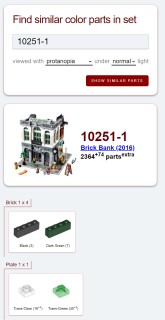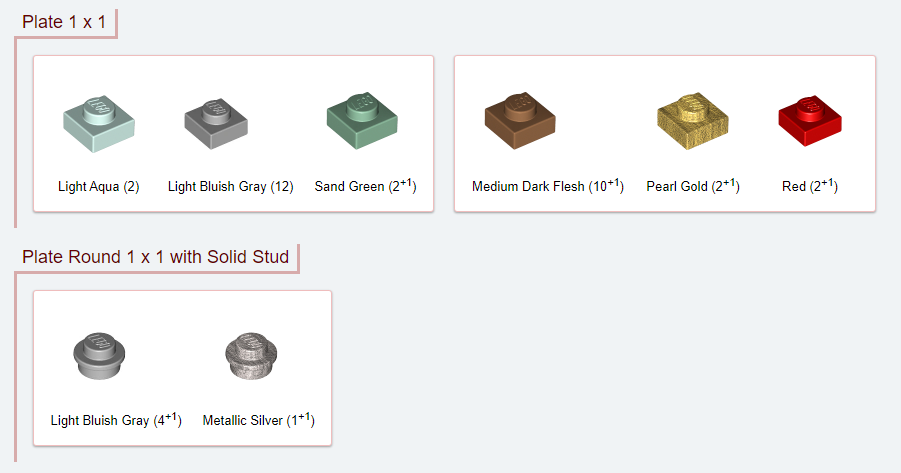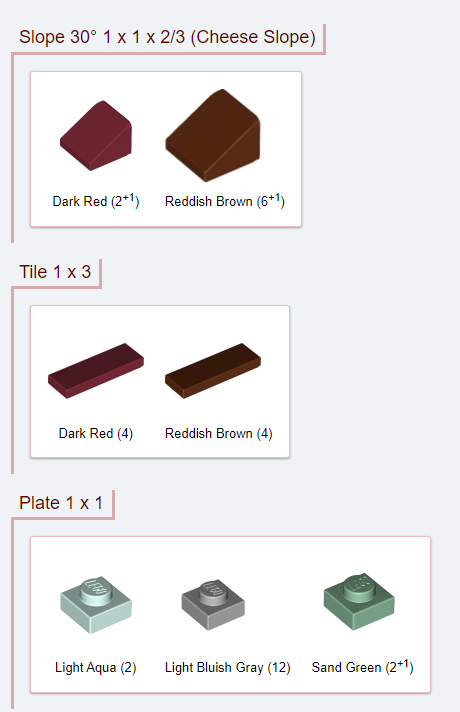New resource for colourblind LEGO builders
Posted by Huw,
When we featured Brickset member Michael, aka Lucent, in our meet a member series last month, he mentioned a website he'd developed to help those with colourblindness determine potentially problematic pieces in sets.
To make it more easily accessible to those of you who might find it useful, I have added a link to it on the set details pages, under the 'Links' tab.
I also asked Michael about the site to find out why he created it and how it works.
Why did you create the site?
For me Lego is a very Zen experience. It’s one of the few times where I’m not in front of a screen but also not doing something so taxing I can’t let my mind wander. But, sharing a form of colorblindness with 1 in 12 men, my irritation with confusing pieces was destroying a lot of the meditative experience of building.
I’d catch myself staring intently at two pieces with no clue whether they were the same or interrupting roommates to come and inspect. I think a lot of us who like Lego are fairly meticulous, so just leaving the wrong colour piece in place was no more an option than leaving the wrong shape piece in place.
However, knowing that there are 8 dark red and 8 reddish brown 1x1 plates in a set, even if I’m not great with colour, helps me a great deal. I can shuffle them around into piles until each pile looks the same, and I don’t have to waste time racking my brain if I know those are the only pieces in a similar colour in the entire set. I caught myself looking through the inventory to figure these things out and thought there’d surely be an easy way to automate it.
What does the site?
Color.brick.design takes the inventory of a set and display which parts in that set occur in multiple colours that a certain colour vision deficiency, or even normal vision, might find similar.
For many sets, it’ll show you nothing at all, either because all the parts are in a distinct colour or if a part is in multiple colours, they’re not similar enough to be confused. There’s a lot of customizability in the type of colour deficiency and whether the parts are looked at under dim lighting.
How does it work?
After fetching the inventory of a set from Rebrickable, it first discards all pieces that occur in only one colour. Then, for each part design, it looks at the colours it occurs in and uses formulas I found (but can’t say I fully understand) to transform that colour into what someone with that particular colour deficiency might see.
So, for deuteranomaly, the most common form of red-green colourblindness, both red and green colours will be transformed into about the same reddish colour. After the transformations are complete, it then compares the colours by placing them as points in the 3-D representation of the Lab colour space. Colour spaces are like 3-D colour wheels, and the Lab space was designed so that how far apart two colours are as points corresponds to how different they look to the human eye. Then, it’s just a matter of measuring the distance between points the way you did in geometry and classifying colours as similar if the distance is less than some threshold, which took some tuning on my part.
The site offers a list of sight conditions to choose from. How do they differ and how do they affect someone's perception of colour?
When hunting for the formula and threshold that best simulated what I thought were similar parts, I came across dozens of others, and even differing formulas for the same conditions.
Some of them are exceedingly rare, but once I had the code in place to handle my deficiency, the additional work to add all others was minimal. Most of them are different forms of red-green, including all the ones starting with d and p, and represent about 4% of humanity--mostly men.
The t-named ones are blue-yellow deficiencies and are only 0.02% of the population. I’m hoping someone gets some value out of the others, even if it’s just the experience of knowing how difficult Lego can be for someone with achromatopsia, a condition only a few thousand people in the entire world have.
Do you have other ideas or plans for improvements?
I’d like to display the choices of colour deficiency in a grid that illustrates how the types relate, so you can still use the site without knowing the names for the types of deficiencies. I'm also open to any suggestions Brickset readers might have for how to improve the site.
I suspect there are a lot of useful non-colour-vision related things that can be done with programmatic access to the inventory of every Lego ever made. I would love to hear ideas from the community, as I really enjoy making small, one-shot sites like this.
What would you like to see “computed” from parts inventory? What pieces two sets have in common? What part occurs in the most distinct colours? What sets you can “almost” make (with percent coverage) from the parts of a larger set?
Thanks, Michael!
The site can be accessed at https://color.brick.design, or from our set details pages
128 likes


32 comments on this article
And resources for colourblind LEGO manufacturers?
This is really cool, well done Michael for setting this up! And thanks Huw for highlighting it, these accessibility tools are so important for wider participation.
Good morning Huw! Great article as always, but there is an unusual problem with the link at the end.
Thank you Michael for tackling the colorblindness issue.
Cheers!
Thanks -- it was because Michael used the incorrect spelling of colour for his subdomain :)
Now corrected.
That's a very useful resource, thanks for developing it! What would be really cool, if possible, would be some way to upload a photo of a piece, or pieces, and have the system identify the colour. There are algorithms out there that can extract the RGB values from pixels in an image and determine the colour, although given all the variables involved (lighting in particular) I don't know how accurate it would be.
This is a brilliant idea. Thanks, Michael. My son is colour blind and always mixes up blue/purple and brown/red and i think this will help him.
This is great. Being colourblind myself I do find some colours extremely difficult to tell apart so anything that can help with this is very welcome.
Brown/red-brown/dark red and dark tan/olive green are my main problem ones but also lime/orange, white/light aqua and dark blue/dark purple if the light is bad or I'm not concentrating.
From personal experience I do find it helpful to have different light sources available i.e. daylight/warm white etc. as I found some colours are more distinguishable under different lights.
It's also very helpful having a non-colourblind wife who I can turn to if I get really stuck!
This might not be useful to me but it will to other people, thanks.
What a fab idea - nice work.
So cool! Love this idea.
Quite a cool resource, and it's nice to see people delve into the subtleties of color blindness, and how it's not just red-green that can cause issues.
That being said, with Lego particularly, what can be done in practice to help them? With a tool like this, they'll know to be careful, but if they can't distinguish them anyways, what can they do`?
A friend of mine has a rare condition that makes him almost blind, and colors are a big issue too. When we played board games, which tend to be quite colorful, we found that using distinguishable symbols, not colors, was the way to go. And nowadays, by design, a lot of people making board games avoid uni-color components. But Lego pieces do not have unique numbers or symbols on them, and by design are almost always uni-color. So what to do then?
Just an idea, but maybe putting parts under a UV light would help distinguish some colors? For instance, vibrant coral glows incredibly brightly, while bright light orange glows more softly under UV light.
Brilliant. Am going to use this.
I recently rebuilt my Slave 1 UCS. I was doing it in the evenings with electric light and mixed up the earth green and new dark red. When i finished and showed my kids they looked at me very oddly and said ‘Dad I think you made a few mistakes’ !!! ;)
I've struggled with lego instructions especially with the black/dark grey/light grey in the past and that's without being colourblind so I dread to think of the difficulties those with colourblindness must have. What a great resource.
I would love to see a periodic table of Lego colors. You could maybe go from most common to rarest, separate metallics from non-metallics, and separate transparent colors as you would gases in the regular periodic table.
What, like this one? https://brickset.com/colours/chart
:-)
This is an excellent resource, I can’t thank you enough - my partner is colourblind and really struggles differentiating sometimes, particularly the reds/browns and greens. I’m sure he’ll find this extremely valuable, great work!
Not really colorblind but I always struggle with the different shades of metallic grays (silver, pearl silver, gunmetal, ect.)
@pvp3020 said:
"That's a very useful resource, thanks for developing it! What would be really cool, if possible, would be some way to upload a photo of a piece, or pieces, and have the system identify the colour. There are algorithms out there that can extract the RGB values from pixels in an image and determine the colour, although given all the variables involved (lighting in particular) I don't know how accurate it would be."
Wonderful idea. Maybe you could have an app version of the website that can access a phone's camera, and you just have to hold the piece in front of the camera to get a reading. The app could have settings so the user could tell it what the lighting conditions are. That would make this resource useful for building MOCs as well as sets.
Many thanks for this great news.
I will try to use it.
I'm colourblind and building LEGO is an art of challenge.
On the instructions it is not always easy especially as the black is never black but more like dark grey.
This is the reason I sometimes ask my daughter or my wife for help.
To differentiate a reddish brown piece from a new dark red one I occasionally use a piece of white paper.
Another issue is with the LEGO parts themselves where the 1 x 4 brick in sand green does not match the 1 x 6 brick (e.g. 10255 Assembly Square) or in my exemplar of the Apollo Saturn V, there are about 50 of the 148 6132212: Brick W/Half Bow 2X3 W/Cut (https://brickset.com/parts/6132212/brick-w-half-bow-2x3-w-cut) which are yellowish.
And this afternoon I was sorting my spare pieces to find two 1 x1 tiles in reddish brown.
@Huw said:
" What, like this one? https://brickset.com/colours/chart
:-)"
Yes, but including every color that Lego has ever produced and perhaps on a separate listing of the colors in order of the number of different parts produced in that color.
Is anyone else weirdly amused that the set they demo this with is the Brick Bank. Often complained about for how colorless it is? (And yeah I get for colorblind people sand green and light bluish grey will be hard to differentiate.)
I'm almost surprised that no one came up with something like that before. The underlying databases are accessible for quite some time now. But good work.
I’m not affected by any color blindness, but have an idea regarding finding out what type of deficiency a user has: a multiple choice test which colors the user can distinguish and then try to create a personal set of thresholds.
J.
Barney Main anybody? He's a famous colorblind AFOL who has amazing MOCs and collaborated on multiple DK Lego Idea books.
Awesome work and thanks for the article to let us know about it. I'm also colorblind and hate progressing on a model to find I used the wrong color pieces 10 steps ago so I have to undo that work to put the correct piece there. The Lego instructions aren't always colored well enough for us colorblind people! ;-)
thanks
Great idea. My cousin is also colourblind, so I might have to let him know.
Colorblind and do the same thing of reading the parts list out of the back to try and figure it out or enlisting help from a passerby. Will definitely try this out. Just did the escape pod vs dewback starwars set and it was painful given how small the set was to spend so much time staring at different pieces for color.
@Namer18 said:
"Colorblind and do the same thing of reading the parts list out of the back to try and figure it out or enlisting help from a passerby. Will definitely try this out. Just did the escape pod vs dewback starwars set and it was painful given how small the set was to spend so much time staring at different pieces for color. "
I relate. Had huge issues with color shades in recent the T-16 and Bantha set.
Thank you!
I'm colourblind and I don't seem to have any problems (at least I don't think I have!) but this is still a great resource to have handy if I need it.
The Lego community always creates great things, and they're not just MOCs.
I'm not colourblind, but this is pretty awesome.
I'm not colorblind (though I have an unusual threshold in my perception of blue vs green - I tend to call certain shades green that others call blue) but I spent several days tracing back ALL building steps of 71043 Hogwarts Castle to find the spot where I put the one 1x1 tile in Medium Blue that was supposed to be the Half-Blood Prince's potions book. Turned out I had used it instead of a 1x1 LBG tile in one of the towers, but the colors were so similar that it was very difficult to spot, especially on a 6000+ piece set.